This article covers some of the many different types of fishes that begin with the letter “T”. The first fish profiled is the Tigerfish, which is a freshwater fish found in Africa. The Tigerfish is known for its large teeth and its ability to leap out of the water to catch its prey.
The next fish is the Tetra, which is a small, brightly-colored freshwater fish found in South America. The Tetra is a popular aquarium fish due to its vibrant colors and peaceful nature. The third fish is the Tilapia, which is a freshwater fish found in Africa and Asia. The Tilapia is a popular food fish due to its mild flavor and low price.
Fishes That Start With The Letter T
Fishes come in all shapes and sizes, from the massive whale shark to the tiny neon tetra. They can be found in every corner of the globe, from the frigid Arctic waters to the warm waters of the tropics. And they come in a dazzling array of colors, from the dull brown of a carp to the iridescent blue of a betta fish. Fishes are an incredibly diverse group of creatures, and there are many different species that start with the letter “T.”
These are just some of the multitude of fishes that start with the letter “T.”
Tilapia
The tilapia is a freshwater fish that is widely consumed as a food source. It is a popular aquaculture species and is often dubbed as the “aquatic chicken” due to its high protein and low fat content. Tilapia can be found in tropical and subtropical regions around the world, and is known to thrive in warm, shallow waters.
Tilapia is a relatively easy fish to farm, which has contributed to its widespread popularity. It is a hardy fish that can tolerate crowded conditions and poor water quality, making it an ideal candidate for aquaculture. Tilapia is also known to be a fast-growing fish, which further adds to its appeal as a food source.
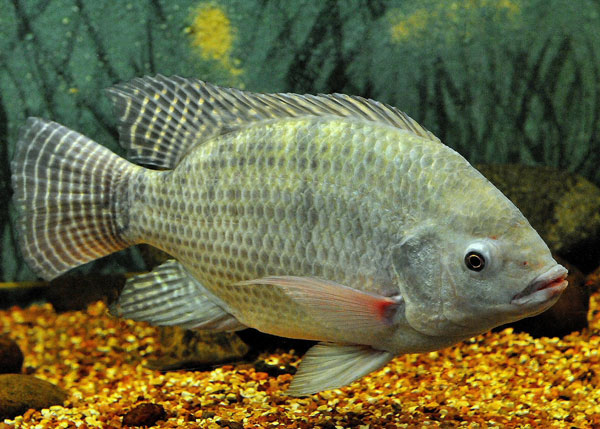
There are a number of different tilapia species that are farmed for food, the most common of which include the Nile tilapia, blue tilapia, and Mozambique tilapia. Tilapia typically have a mild-tasting flesh that is firm and flaky. The fish can be cooked in a variety of ways and is often used as a substitute for other fish in recipes.
Trout
Trout is a type of freshwater fish that belongs to the salmon family. There are a number of different trout species, the most common of which include the brown trout, rainbow trout, and brook trout. Trout are found in cold-water streams and rivers across the world, and are a popular target for recreational fishing.
Trout are relatively easy to catch, which has made them a popular choice for anglers. The fish are known to put up a good fight when hooked, making them all the more fun to catch. Trout are also a popular food fish, and their flesh is considered to be delicious.
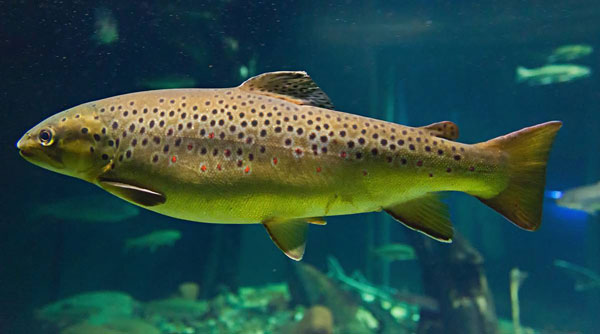
Trout can be cooked in a number of different ways, the most popular of which include baking, frying, and smoking. The flesh of the trout is firm and flaky, and has a mildly sweet taste. Trout is often considered to be a healthier alternative to other types of fish, as it is lower in fat and calories.
Tuna
Tuna is a type of saltwater fish that is widely consumed as a food source. It is a popular choice for sushi and sashimi, as well as being used in a variety of cooked dishes. Tuna is found in the open ocean, and is a popular target for both commercial and recreational fishing.
There are a number of different tuna species, the most common of which include the bluefin tuna, albacore tuna, and yellowfin tuna. Tuna are large fish, and can weigh anywhere from 20 to 1000 pounds. The flesh of the tuna is pinkish in color, and is considered to be very flavorful.

Tuna is a popular food fish due to its high protein and low fat content. It can be cooked in a number of different ways, including being grilled, baked, or canned. Tuna is often used in sushi and sashimi, as well as being a popular ingredient in canned tuna fish.
Tilefish
Tilefish is a type of saltwater fish that is found in the Atlantic Ocean. It is a popular choice for seafood lovers, as it has a delicate and sweet flavor. Tilefish is typically found at depths of around 600 feet, which makes it a bit.
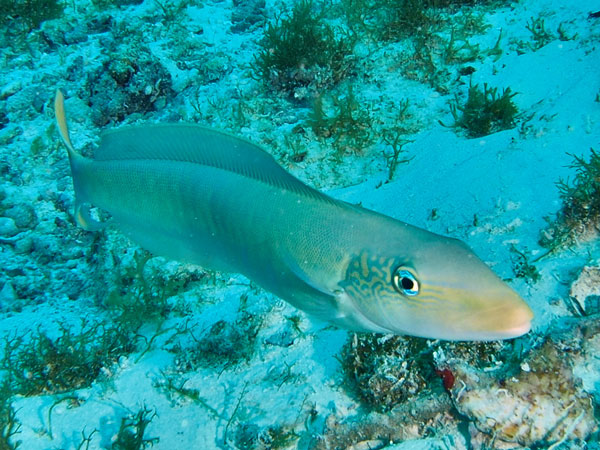
Tadpole Fish
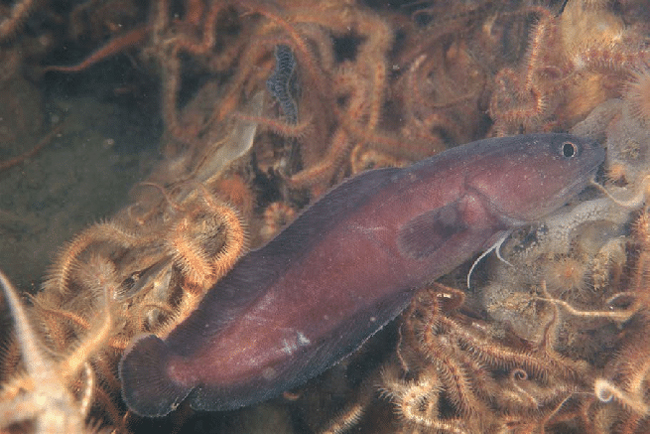
The Tadpole Fish, also known as the Asian Arowana, is a truly unique and fascinating fish. As its name suggests, it bears a resemblance to a tadpole in its juvenile stage, with a long, slender body and a large, rounded head. As it matures, the Tadpole Fish develops a more elongated body and a forked tail, but it retains its signature large head and prominent eyes. These eyes are not only big but also intelligent, making the Tadpole Fish a highly prized aquarium fish for enthusiasts.
The Tadpole Fish is native to Southeast Asia, where it inhabits slow-moving rivers and streams. It is a carnivorous fish, feeding on insects, small fish, and crustaceans. In the wild, it can grow up to 3 feet long, but in captivity, it typically reaches around 1-2 feet. The Tadpole Fish is known for its jumping ability, and it has been observed leaping out of the water to catch prey.
The Tadpole Fish is a popular aquarium fish due to its beauty, intelligence, and hardiness. However, it is not a fish for beginners. It requires a large tank (at least 100 gallons) and special care, including a diet of live or frozen food. If you are an experienced aquarist looking for a challenge and a rewarding fish to keep, the Tadpole Fish may be the perfect pet for you.
Interesting facts about Tadpole Fish:
- The Tadpole Fish is considered a lucky charm in some cultures.
- It is one of the most expensive aquarium fish in the world, with some specimens fetching tens of thousands of dollars.
- The Tadpole Fish is a threatened species due to habitat loss and overfishing.
I hope this information is helpful! Let me know if you have any other questions.
Telescopefish
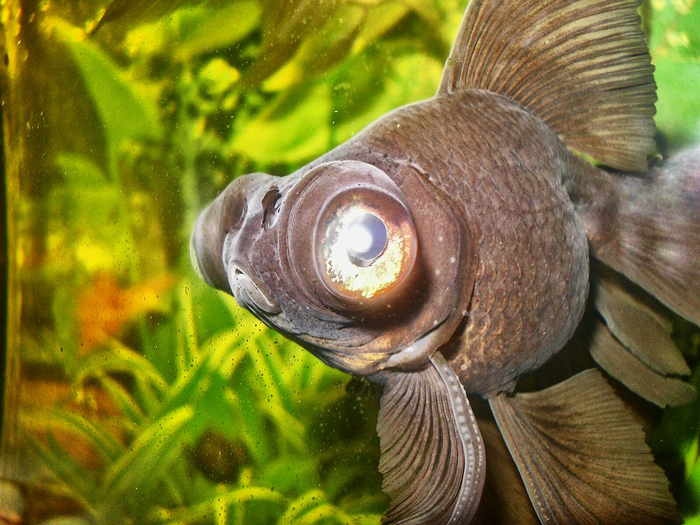
The Telescopefish is a stunning freshwater fish known for its bulging eyes that resemble, you guessed it, telescopes! These large, protruding eyes are actually a result of selective breeding, and they can be quite delicate. Despite their delicate eyes, Telescopefish are relatively hardy fish and are suitable for aquariums with experienced owners.
These fish come in a variety of colors, including red, white, orange, and black, and they often have beautiful patterns on their bodies. They can grow up to 10 inches long and are relatively peaceful fish, making them good tank mates for other peaceful fish. However, their slow swimming speed and large eyes can make them vulnerable to faster, more aggressive fish.
Telescopefish are native to China and were first bred in the 17th century. They are now a popular aquarium fish around the world. If you are considering adding a Telescopefish to your aquarium, be sure to do your research to ensure that you can provide them with the proper care. They require a spacious tank (at least 30 gallons) with plenty of hiding places and good water quality. They are also relatively sensitive to water changes, so it is important to be careful when performing maintenance on your tank.
Interesting facts about Telescopefish:
- Telescopefish have poor eyesight due to their protruding eyes.
- They are relatively long-lived fish, with some specimens living up to 20 years in captivity.
- Telescopefish are sometimes called “goldfish with telescopes” because of their resemblance to goldfish.
Temperate Perch
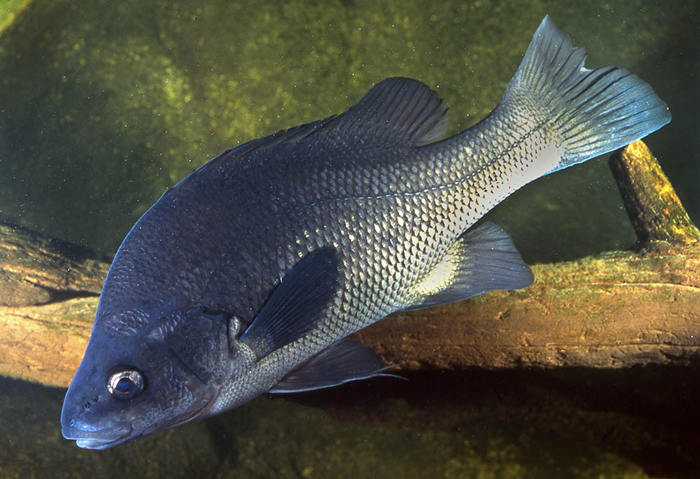
The Temperate Perch is a small fish found in freshwater habitats in Europe, Asia, and North America. It is a member of the Percidae family, which also includes fish like walleye and yellow perch. Temperate perch are typically 6-12 inches long and have a slender body with a slightly upturned mouth. They are olive-green to brown in color with darker vertical stripes on their sides.
Temperate perch are schooling fish and are often found in large groups near the edges of lakes and rivers. They are omnivorous and feed on a variety of small prey, including insects, worms, and crustaceans. They are also preyed upon by larger fish, birds, and mammals.
Temperate perch are popular sport fish in some parts of the world. They are relatively easy to catch and put up a good fight on light tackle. They are also good table fare, although their small size means that they don’t yield a lot of meat.
Interesting facts about Temperate Perch:
- Temperate perch can live for up to 10 years in the wild.
- They are an important part of the food chain in freshwater ecosystems.
- Temperate perch are sometimes used as bait
Tarwhine (Terapon jarbua)
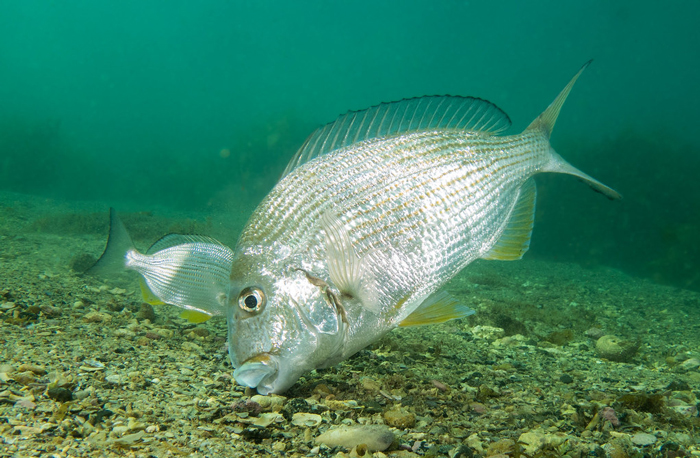
The Tarwhine, with its shimmering silver scales and striking black stripes, is a vibrant resident of coral reefs in the Indo-Pacific. Reaching a maximum length of around 10 inches, these medium-sized fish are social creatures, often forming large schools that dart and swirl through the waters. Their agility is impressive, as they can maneuver between crevices and coral branches with impressive speed.
Tarwhines are omnivores, feasting on a diverse menu of plankton, small crustaceans, and even algae. They have a unique feeding method – they use their mouths like vacuum cleaners, sucking up food particles from the water column. During spawning season, male Tarwhines transform into dazzling displays of color, their bodies flashing bright yellow and blue to attract mates. Females lay their eggs in sheltered areas, leaving parental duties to the currents.
These lively fish are a welcome addition to saltwater aquariums, adding a touch of tropical flair. However, they require an experienced aquarist, a spacious tank with ample swimming space, and good water quality. Their social nature makes them ideal tank mates for other peaceful fish of similar size.
Interesting facts about Tarwhine:
- Tarwhines can change color quickly, flashing yellow and blue during courtship.
- They are important indicators of coral reef health, as they depend on healthy reefs for food and shelter.
- Their scales shimmer with silver thanks to tiny crystals called guanine, the same compound found in pearls.
Thornfish (Bodianus spp.)
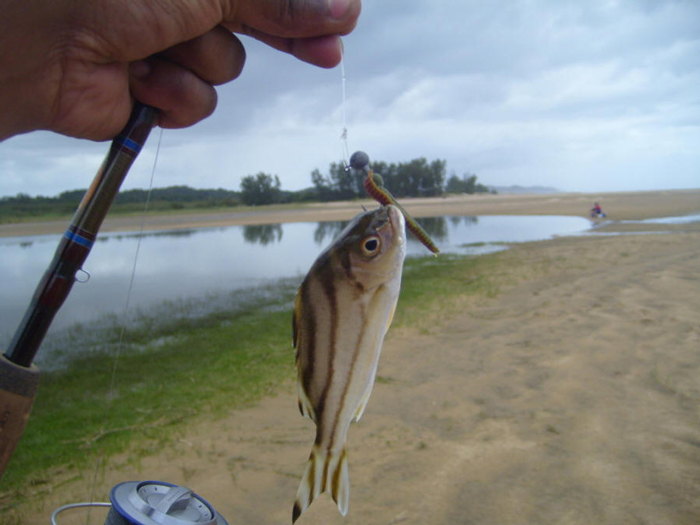
With over 100 species under the “Thornfish” umbrella, it’s like diving into a kaleidoscope of vibrant colors and diverse patterns. Found in tropical coral reefs around the world, these lively fish range in size from a petite 3 inches to an impressive 3 feet! Whether adorned with bold stripes, dazzling spots, or intricate geometric patterns, each Thornfish species boasts a unique and eye-catching appearance.
These feisty fish are territorial and solitary, fiercely defending their patch of reef with nips and chases. They’re omnivores, feasting on a variety of crustaceans, worms, and algae. Their sharp teeth and strong jaws allow them to pry open mollusks and even crush hard-shelled crabs. Interestingly, some Thornfish species have cleaning symbioses with shrimp, allowing the shrimp to remove parasites and debris from their scales in exchange for protection.
While some Thornfish species are prized aquarium fish, due to their beauty and hardiness, they require experienced care. Their territorial nature means a spacious tank with plenty of hiding spaces is essential. They’re also best kept with larger, peaceful fish that can withstand their occasional outbursts.
Interesting facts about Thornfish:
- Some Thornfish species exhibit “sexual dichromatism,” meaning males and females have different colors and patterns.
- They have incredible jaws that can crack open even the toughest shellfish.
- Some Thornfish have venomous spines on their dorsal fins, used for defense against predators.
Thresher Shark (Alopias spp.)
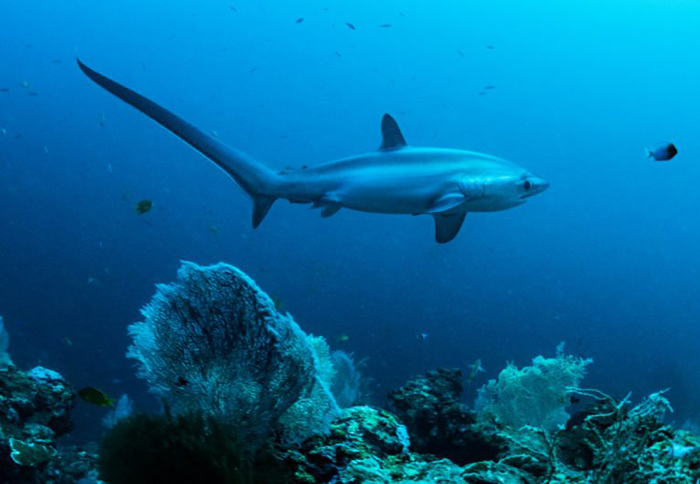
Imagine a sleek, torpedo-shaped shark with an enormous scythe-like tail longer than its body! That’s the Thresher Shark, a master of the open ocean found in tropical and temperate waters worldwide. These magnificent creatures can reach up to 20 feet in length, with their elongated tails accounting for half that size! This remarkable appendage serves a dual purpose: as a powerful rudder for propelling themselves through the water and as a formidable weapon for stunning and disorienting prey.
Thresher Sharks are opportunistic feeders, preying on a variety of schooling fish like mackerel, herring, and squid. Their hunting technique is mesmerizing – they whip their tails through the water like a whip, stunning their prey before devouring them. Despite their fearsome appearance, Thresher Sharks are not a threat to humans. They are solitary creatures, often encountered by divers in deep, offshore waters.
Unfortunately, these awe-inspiring sharks face threats from overfishing due to their valuable fins. As such, some Thresher Shark species are listed as vulnerable or endangered. Conservation efforts are crucial to ensure their survival in our oceans.
Interesting facts about Thresher Shark:
- Their whip-like tails can deliver blows powerful enough to break fish bones.
- They are excellent long-distance swimmers, migrating thousands of miles each year.
- Thresher Sharks give birth to live young, with litters ranging from 4 to 12 pups.
Tiger Shark (Galeocerdo cuvier)
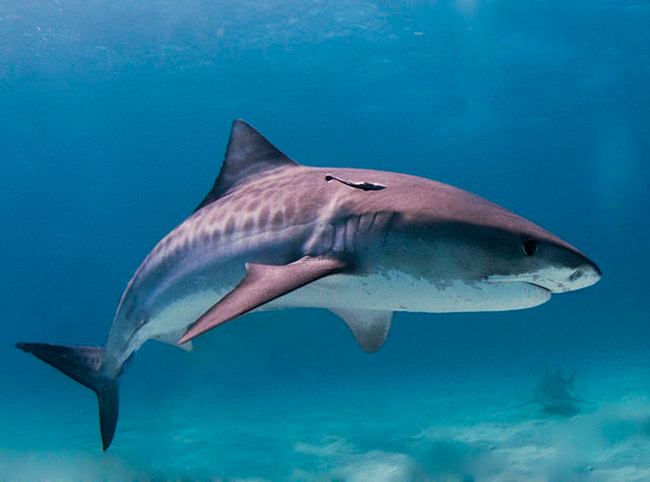
Imagine a sleek, powerful predator prowling the deep blue, striped with bold markings like a jungle cat. That’s the Tiger Shark, a magnificent and often misunderstood inhabitant of tropical and subtropical oceans. Reaching up to 14 feet in length, these sharks are named for their distinctive dark stripes that stand out against their lighter bodies, resembling the stripes of a tiger.
Tiger sharks are apex predators, meaning they sit at the top of the food chain. They’re opportunistic feeders, devouring a wide variety of prey like fish, sea turtles, dolphins, and even other sharks. Their powerful jaws and sharp teeth can crush through shells and bones, making them formidable hunters. Interestingly, they have a keen sense of smell and can detect even tiny amounts of blood in the water from miles away!
Despite their fearsome reputation, Tiger sharks rarely attack humans. However, due to their unpredictable nature and powerful jaws, it’s important to exercise caution and avoid swimming alone in areas where they are known to occur. Conservation efforts are crucial for protecting these majestic creatures, as they play a vital role in maintaining healthy ocean ecosystems.
Fun facts about Tiger Sharks:
- They are known for their insatiable appetites and have been nicknamed “garbage disposals of the sea” due to their tendency to eat almost anything.
- Tiger sharks can live for up to 50 years!
- They are ovoviviparous, meaning they give birth to live young that have hatched from eggs inside their mother’s body.
Tidewater Goby (Euphrynion alburnus)
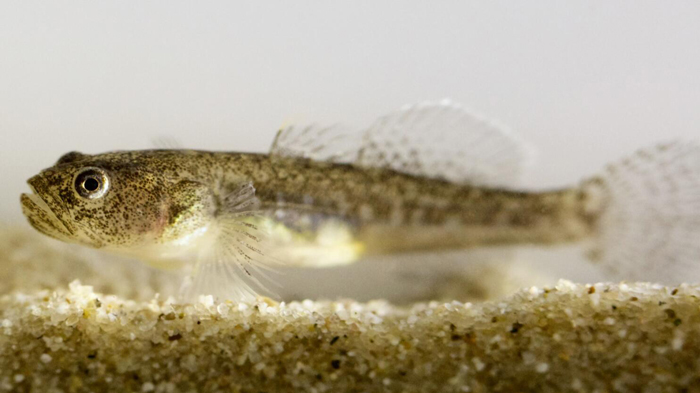
Picture a tiny, energetic fish zipping through tidal pools and seaweed forests, leaving behind a trail of shimmering scales. That’s the Tidewater Goby, a fascinating little fish found along the rocky shores of the Atlantic Ocean, from Canada to North Carolina. These miniature marvels rarely exceed 3 inches in length, but their vibrant personalities and curious nature make them a delight to observe.
Tidewater Gobies are masters of camouflage, changing their color to blend in with their surroundings. They’re opportunistic feeders, nibbling on algae, small crustaceans, and even fish eggs. Their powerful fins allow them to cling to rocks and seaweed, even in strong currents, making them well-adapted to their rocky intertidal habitat.
These hardy fish are relatively easy to care for in aquariums, making them popular choices for home aquarists. However, their small size and specific dietary needs require a dedicated and knowledgeable owner. Observing Tidewater Gobies in an aquarium can be a captivating experience for children, teaching them about adaptation, camouflage, and the wonders of the intertidal zone.
Fun facts about Tidewater Gobies:
- They are social creatures and often live in large groups called schools.
- Male Tidewater Gobies perform elaborate courtship displays to attract mates.
- These tiny fish have surprisingly large brains, relative to their body size.
Torrent Catfish (Sisoridae family)
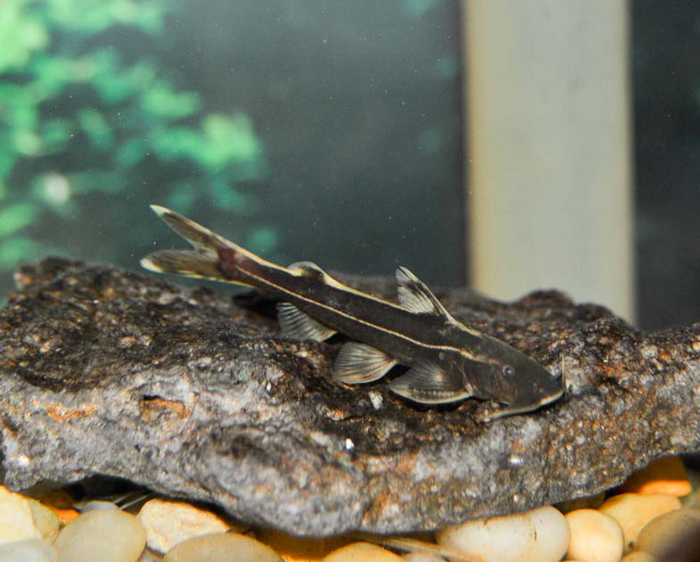
Imagine a sleek, whiskered fish clinging to rocks in a rushing mountain stream, defying the current with its powerful fins. That’s the Torrent Catfish, a remarkable family of freshwater fish found in fast-flowing rivers and streams around the world. These tenacious underwater acrobats come in a variety of shapes and sizes, ranging from a few inches to over 3 feet in length, each adapted to survive in the turbulent waters they call home.
Torrent Catfish have flattened bodies and specially adapted fins that help them cling to rocks and navigate the swift currents. Their mouths are positioned underneath their heads, allowing them to vacuum up food particles and small invertebrates from the streambed. Some species even have barbs on their bodies that help them grip slippery rocks.
These fascinating fish are important indicators of the health of freshwater ecosystems. Their sensitivity to pollution makes them valuable tools for monitoring water quality. Observing Torrent Catfish in their natural habitat can be a thrilling experience, showcasing the power and resilience of life in the fast-flowing world of mountain streams.
Fun facts about Torrent Catfish:
- Some Torrent Catfish species can produce clicking sounds to communicate with each other.
- They have excellent eyesight, which helps them navigate the murky waters of mountain streams.
- Torrent Catfish lay their eggs on rocks in the fast-flowing current, where they are protected from predators.
Trumpetfish (Aulostomus spp.)

Imagine a playful underwater trumpet, adorned with bright stripes and sporting a long, slender snout. That’s the Trumpetfish, a captivating resident of coral reefs in tropical and subtropical waters worldwide. Reaching up to 3 feet in length, these fish come in a variety of vibrant colors, with some species boasting bold stripes or spots, making them true underwater fashionistas.
Trumpetfish aren’t just about looks – their elongated snout serves as a powerful suction tool, perfect for capturing small fish, shrimp, and plankton. They stalk their prey patiently, then shoot out their snout like a vacuum cleaner, sucking them in with incredible speed. These playful fish are often seen swimming in pairs or small groups, flitting through the coral with their long snouts waving gracefully.
Trumpetfish are relatively easy to care for in aquariums, making them popular choices for experienced aquarists. However, their large size and specific dietary needs require an adequately sized tank and plenty of live or frozen food. Observing Trumpetfish in an aquarium can be a mesmerizing experience, teaching children about adaptation, feeding strategies, and the vibrant life of coral reefs.
Fun facts about Trumpetfish:
- They have excellent eyesight and can spot prey hiding among the coral.
- Trumpetfish can change their color slightly to blend in with their surroundings.
- Some species have venomous spines on their dorsal fins, used for defense against predators.
Trunkfish (Ostraciidae family)
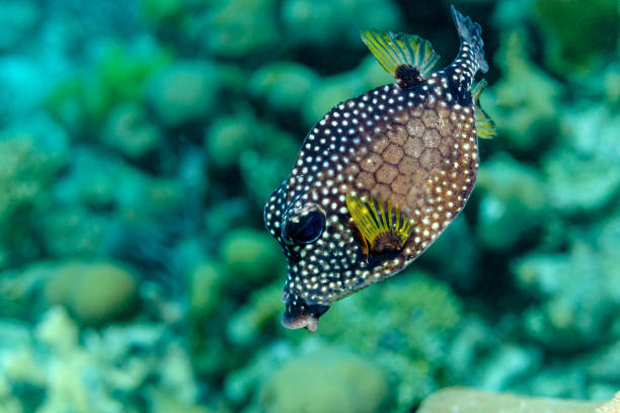
Picture a tiny underwater box adorned with beautiful patterns and sporting curious bumps and horns. That’s the Trunkfish, a unique and fascinating family of fish found in coral reefs and warm temperate waters around the world. These boxy fellows come in a variety of shapes and sizes, ranging from a few inches to over 2 feet in length, each adorned with their own quirky armor and colorful designs.
Trunkfish have hard, bony plates covering their bodies, acting like a personal suit of armor. This defense mechanism allows them to slowly graze on algae and sponges without fear of predators. Some species even have spines and horns as extra deterrents. They’re relatively slow swimmers but make up for it with their clever camouflage and unique shapes.
Trunkfish are not suitable for most home aquariums due to their specific dietary needs and territorial nature. However, observing them in a public aquarium or during a snorkeling trip can be a delightful experience, sparking curiosity about their unusual body shapes and fascinating adaptations.
Fun facts about Trunkfish:
- Some Trunkfish species can puff up their bodies with water to appear larger and intimidate predators.
- They have powerful jaws that help them crack open hard-shelled prey like clams and crabs.
- Trunkfish often mate for life and form monogamous pairs.
Trout Cod (Macruronus novaezelandiae)
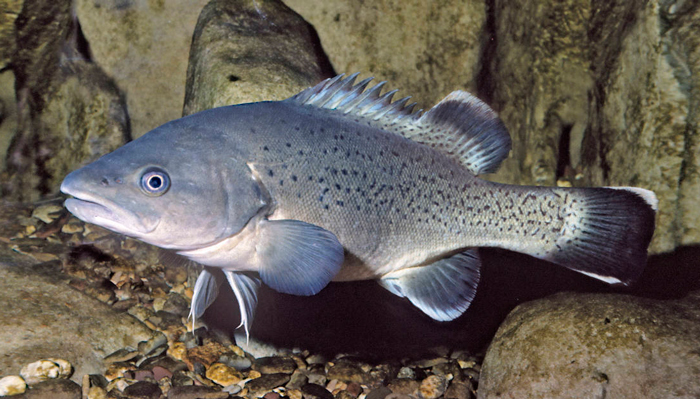
Get ready to dive into the deep, cold waters of the Southern Ocean and meet the magnificent Trout Cod. This large, robust fish can reach up to 6 feet in length and is a key player in the ecosystem of the Southern Hemisphere. Imagine a giant cod with shimmering scales, a prominent chin barbel, and large, inquisitive eyes, adapted to the darkness of the deep sea.
Trout Cod are bottom feeders, scavenging for food on the seafloor. They use their sensitive barbel to detect prey hidden in the sediment, such as worms, crustaceans, and even small fish. Their large mouths and sharp teeth can crush through hard shells and bones, making them efficient predators in their deep-sea environment.
Trout Cod are commercially important fish but are caught sustainably. Observing them in their natural habitat is a rare treat, usually possible only through research expeditions or deep-sea documentaries. However, learning about them fosters appreciation for the diverse and often unseen life thriving in the dark depths of our oceans.
Fun facts about Trout Cod:
- They can live for over 50 years!
- Trout Cod have antifreeze proteins in their blood, allowing them to survive in the frigid waters of the Southern Ocean.
- They are migratory fish and can travel thousands of miles each year.
64 Fishes Beginning With T
| Tadpole cod | Tadpole fish |
| Tailor | Taimen |
| Tang | Tapetail |
| Tarpon | Tarwhine |
| Telescopefish | Temperate bass |
| Temperate ocean-bass | Temperate perch |
| Tench | Tenpounder |
| Tenuis | Tetra |
| Thorny catfish | Thornfish |
| Threadfin | Threadfin bream |
| Thread-tail | Three spot gourami |
| Threespine stickleback | Three-toothed puffer |
| Thresher shark | Tidewater goby |
| Tiger barb | Tigerperch |
| Tiger shark | Tiger shovelnose catfish |
| Tilapia | Tilefish |
| Titan triggerfish | Toadfish |
| Tommy ruff | Tompot blenny |
| Tonguefish | Tope |
| Topminnow | Torpedo |
| Torrent catfish | Torrent fish |
| Trahira | Treefish |
| Trevally | Triggerfish |
| Triplefin blenny | Triplespine |
| Tripletail | Tripod fish |
| Trout | Trout cod |
| Trout-perch | Trumpeter |
| Trumpetfish | Trunkfish |
| Tubeblenny | Tube-eye |
| Tube-snout | Tubeshoulder |
| Tui chub | Tuna |
| Turbot | Two spotted goby |
Conclusion
There are many different types of fish that start with the letter “T”. These include the Tigerfish, Tilapia, and the Tetra. Each of these fish has their own unique features and benefits. The Tigerfish is a predatory fish that is known for its ferociousness, while the Tilapia is a popular food fish that is known for its mild flavor. The Tetra is a small, brightly-colored fish that is popular in the aquarium trade. All of these fish are popular for different reasons, and all have their own unique place in the animal kingdom.



